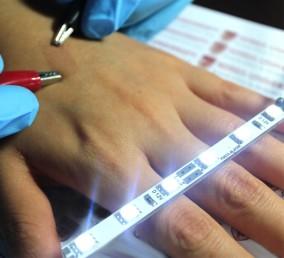New electroplated polymer paves the way for electronic skin
There’s a new nanomaterial in the works that’s offering promise in bendable, wearable electronic devices. Researchers from University of Illinois at Chicago and Korea University have been working with an electroplated polymer which makes transparent, highly conductive, ultrathin film.
The ultrathin film, which is transparent and highly conductive to electric current, was produced simply and inexpensively by the team.
The film, which is actually a mat of tangled nanofiber, electroplated to form a “self-junctioned copper nano-chicken wire,” is also bendable and stretchable, which means it has a plethora of futuristic applications such as roll-up touchscreen displays, wearable electronics, flexible solar cells and even electronic skin.

“It’s important, but difficult, to make materials that are both transparent and conductive,” said Alexander Yarin, UIC Distinguished Professor of Mechanical Engineering, one of two corresponding authors on the publication.
According to the team member Sam Yoon, who is also a corresponding author and a professor of mechanical engineering at Korea University, the new material sets a “world-record combination of high transparency and low electrical resistance.”
It’s also a durable material, keeping its properties in tact even after repeated cycles of severe stretching or bending, which is incredibly important for touchscreens or wearables.
The material was made by electrospinning a nanofiber mat of polyacrylonitrile (PAN) whose fibers are about one-hundredth the diameter of a human hair. The fiber shoots out like a rapidly coiling noodle, which when deposited onto a surface intersects itself a million times.
“The nanofiber spins out in a spiral cone, but forms fractal loops in flight,”said Yarin. “The loops have loops, so it gets very long and very thin.”
The PAN polymer alone is not conductive, so it had to be spatter-coated with a metal in order to attract metal ions. Then, the fiber was electroplated with copper, but could also work with silver, nickel or gold.
The electrospinning and electroplating are both relatively high-throughput and only take a few seconds each, which makes this a commercially viable processes, according to the researchers.
“We can then take the metal-plated fibers and transfer to any surface — the skin of the hand, a leaf, or glass,” said Yarin. An additional application may be as a nano-textured surface that dramatically increases cooling efficiency.
The “self-fusion” by electroplating at the fiber junctions reduces the contact resistance and also accounts for the nanomaterial’s physical resiliency.
The transparent aspect of the material comes from the fact that the material is mostly made of holes, making it about 92% transparent.

Comments are closed, but trackbacks and pingbacks are open.